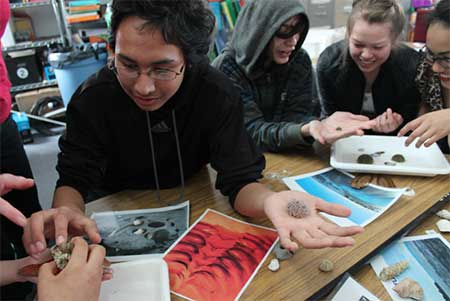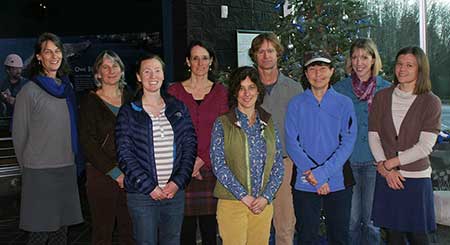Alaska Fish & Wildlife News
September 2015
Change is in the Wind for Kachemak Bay
National Estuarine Research Reserve

The Kachemak Bay National Estuarine Research Reserve (KBNERR) is undergoing a sea change. We are parting ways with our current state partner, the Alaska Department of Fish and Game, Sport Fish Division (ADF&G), and have entered into a new partnership with the Alaska Center for Conservation Science (ACCS) at the University of Alaska, Anchorage. We will soon end our 11-year occupancy of the Alaska Islands and Ocean Visitor Center, but we’ll remain in Homer. We'll be at our current location through August, and we'll move during the month of September to our new location on Kachemak Drive across from Homer Air.
A little background is in order. KBNERR is part of the National Estuarine Research Reserve System and receives guidance and funding from the National Ocean and Atmospheric Administration (NOAA). Like the other 27 Reserves in the system, KBNERR is paired with and receives matching funds from a state partner; and since our designation in 1999 that state partner has been ADF&G.
The mission of the Reserve is to enhance understanding and appreciation of the Kachemak Bay estuary and adjacent waters to ensure that these ecosystems remain healthy and productive. In keeping with this mission, the Reserve provides place-based coastal and nearshore research, education, and training in the "living laboratory" of Kachemak Bay. KBNERR engages in marine invasive species monitoring, oceanographic and coastal processes research, and studies of juvenile salmon rearing in estuarine and headwater habitats. This science is translated by way of hands-on programs, lectures, and workshops to the public, K-12 student, and coastal address current coastal resource issues.

This integrated approach has, for the past 16 years, been supported and administered by ADF&G. Now however, due to State budget cuts and a mutually recognized misalignment of missions, ADF&G can no longer support the Reserve as it has in the past and will cease to be our State partner on July 1st.
In fact, ADF&G made the difficult decision to end the partnership a year ago. But thanks to an outpouring of support from the community of Homer and local legislators, Senate appropriations provided the matching funds needed to keep us operating through the current fiscal year. That year of funding provided ADF&G and Reserve staff with the time needed to successfully engage with UAA and pave the way for a transition to the University’s ACCS program, whose mission aligns very closely with KBNERR’s.
Moving forward, ACCS will fulfill their new role as administrative partner by providing program direction and administrative support. At the same time ADF&G’s Sport Fish Division has committed to support KBNERR through the federally-funded State Wildlife Grant program, which will lend continuity to our long-term salmon research, harmful species program, and fishing education.

KBNERR will transition to UAA with a permanent staff of five, down from a high of 14 just six years ago. A smaller staff brings in fewer grants and the annual support provided by NOAA for building costs and key staff salaries has not increased in several years. UAA’s ACCS director, Keith Boggs, is committed to retaining all existing staff positions, but doing so requires a return to the Kachemak Drive modular building, where we first started out.
Our departure from the Alaska Islands and Ocean Visitor Center, which is owned by our building partner, the Alaska Maritime National Wildlife Refuge, will take place in September. Despite the a sense of loss we feel in leaving this wonderful facility, Reserve staff look forward to continued partnerships and new and exciting horizons as we set sail under the ACCS flagship.
Jessica Ryan Shepherd is the Acting Reserve Manger of the Kachemak Bay Research Reserve
Subscribe to be notified about new issues
Receive a monthly notice about new issues and articles.
